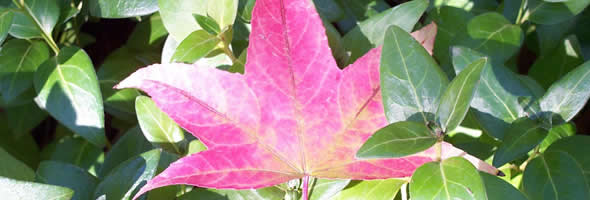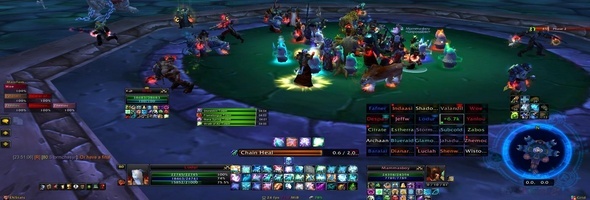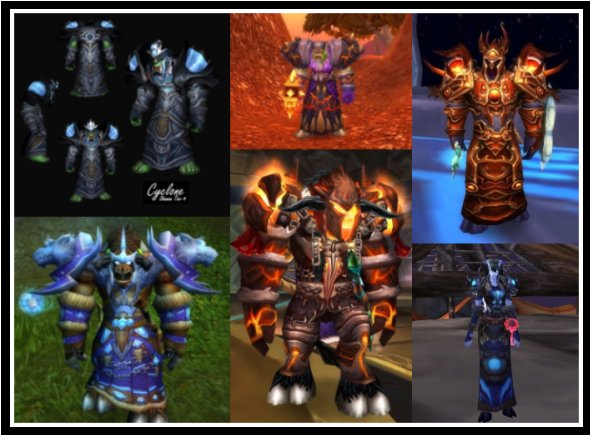
For the record, Moonkins are wonderful. I love them, and I love their dance. However, I am not going to be shaking a tailfeather–at least not for a little while. I might be the only crazy tree out there, but I’m going to use both of my specs for healing, at least for the time being. I expect to be in Ulduar tonight, and quite honestly, no one really knows how difficult it’s going to be. None of us have raided with our usual setups on the PTR, and many of us, me included, never made it there at all. We quite simply don’t know how we, as individual raid groups, will confront the challenges. Thus, it’s a great time to take two healing specs–one for raid healing, and one for tank healing. The changes to mana regen and to some individual spells (ahem, Lifebloom) may make your usual healing assignment no longer the order of the day. Are two healing builds overkill? Maybe. But are they fun? Oh yes, for me anyway.
Build #1: Single tank focused
I am working on the assumption that rolling Lifebloom on multiple tanks is good and dead, so that technique is not part of my calculations. My talent build for tank healing focuses on propping up Nourish, Rejuvenation, and Regrowth. The druid tank healer will do a version of what she’s always done: load HoTs on the tank and then cast a direct heal. The only change for me is that this heal will now be Nourish instead of Regrowth. My tank-healing spec is a version of the 14/0/57 build many of us have been using throughout Naxx, so there are very few surprises. Follow this link to see the build, but I’ll mention the key talents here.
#1: Nature’s Splendor
This talent makes direct healing much easier. The longer your HoTs tick, the more casts of Nourish you can sneak in the rotation.
#2: Nature’s Grace
This talent has been updated to benefit Nourish-heavy rotations. There’s no need to worry about Nourish clipping. An extra haste proc, of course, benefits direct healing much more than HoTs.
#3: Tranquil Spirit
Once an optional talent, Tranquil spirit looks better with the new mana constraints. Druid healers who rely on Nourish for tank filler healing should pick this one up.
#4: Nature’s Bounty
This talent replaces the old Improved Regrowth. It is the one change that cements Nourish’s place in the druid’s rotation. Do not leave the trainer without it.
#5: Living Seed
This talent used to account for less than 1% of my healing, which encouraged me to drop it altogether. Now it procs from overheal in addition to effective healing, making it a better safeguard for a tank target.
Glyphs for Tank Healing
I am going to glyph for Swiftmend, Nourish, and Innervate for my tank healing needs. Your mileage may vary. The glyphs of Lifebloom and Regrowth might still be interesting for certain playstyles, but I’m keeping Innervate until I’m sure I don’t need it.
Build #2: Raid Healing with Healing Touch
What I’m going to share with you is a bit unorthodox and is NOT to be used for tank healing. This build only becomes possible if you have another healing spec to switch to for tank healing or multitasking. In this particular raid healing build, I am going to take the opportunity to try out some new techniques. The basic idea is that Ulduar is an unknown quantity. This build de-emphasizes HoT combos, which is the druid’s strength in tank healing or in normal content. This build features a glyphed Healing Touch, which I know from experience can help when 1) the druid is undergeared for the throughput needed or 2) the druid is running around like a chicken with her head cut off. Don’t worry, there’s a second build coming up later that’s a more standard build for raid healing. The basic technique with this first build is to use Wild Growth and Rejuvenation very liberally and to save that quick HT for heavy damage targeted on a small number of raid members. Mana survival in this build depends on not spamming HT, but rather using it judiciously. The reason I’ve preferred it to the similar Nourish is that it has a decent throughput with no prior HoT setup. Regrowth might work in this role too, but it tends to be a little too slow when the healer is surprised by damage. Just as a note, with this build, Nature’s Swiftness gets used with Regrowth.
Caveat: Yes, I know I’m advocating a flash heal as a raid heal. If your team has extra paladins who end up raid healing, it wouldn’t look as good. However, if you’d been reading my guild’s WWS reports for early Naxx or harder heroics back when we were undergeared, you would have seen glyphed Healing Touch kick the ass of Nourish, Regrowth, and Swiftmended Rejuvenation as a raid heal. I credit Sthirteen with putting a glyphed HT to great use (and outperforming me and my conventional build every time).
Naturalist: Clipping be damned. Yes, your Healing Touch casts will be so fast they’ll clip. With this build, I don’t intend to use more than one at a time. It’s not set up for constant heal bombs on a tank. This is more of a run, run, heal, run, run kind of build.
Tranquil Spirit: Necessary for survival with glyphed HT. The spell is a resource hog, and you’ll need every ounce of mana efficiency.
Revitalize: With this build, the druid will be seeding the raid really heavily with Rejuvenation and Wild Growth. This little talent puts the damage buffer of those two HoTs to a secondary use. One of the things that remains to be seen is how effective Revitalize really is. I’m not counting on huge benefits, but if I’m using the affected spells anyway? Might as well.
Glyphs for HT-oriented raid healing
I’ll be using Healing Touch, Wild Growth, and Innervate for this build. I know, no Swiftmend. Believe me when I tell you that I’ll need the glyph of Innervate to sustain any amount of HT usage.
Build #3: Raid Healing Standard Build
I will likely switch to this build when I get more comfortable with Ulduar. It has more mana efficiency than the HT build, and thus it might let the raid healing druid sneak some HoTs onto the tank. My experience with the HT build is that it’s only really great when multiple healers are undergeared or don’t know WTF to do. I’d never take it as an all-purpose build, because it really reduces the druid’s rotation. With this second raid healing build, I will continue to cast Wild Growth and Rejuvenation liberally. Additionally, once I complete the 4pc T8 set bonus, raid healing with Rejuvenation will be positively delightful. I won’t need my direct heals nearly as much. However, I’ll be using Regrowth as a direct heal on targets with no existing HoT and Nourish as a direct heal on targets that already have one HoT. Swiftmend will also be extremely prominent with this build. For healing on the run, both Rejuv and Lifebloom might be cast on the target, particularly if the raid is spread out enough to make Wild Growth wasteful. The key talents are below.
Swiftmend: I can’t emphasize this enough for this build, but well, any good tree has this anyway.
Nature’s Bounty: I need to buff my two direct heals in order to deal with targeted boss effects.
Revitalize: The very heavy reliance on Wild Growth and Rejuvenation ensures the inclusion of this talent.
Glyphs for Raid Healing
My “standard” raid healing build uses the glyphs of Swiftmend, Wild Growth, and Innervate until I get the 4pc T8 bonus. With the bonus, the glyphs become Swiftmend, Wild Growth, and Rejuvenation.
As a final comment, why would I carry two healing specs when one would do? Because now I can! And also, I apparently didn’t get enough fun out of doing dailies with a Resto spec. At least that gives me a little time to look at elf-Syd instead of a tree or a bird.



